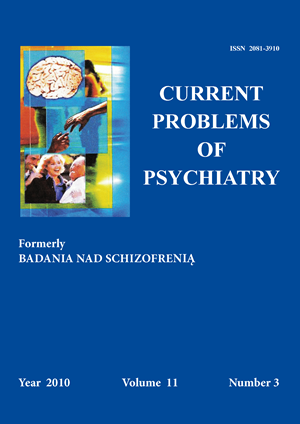Psychometric propertiesof a Personality Traits Questionnaire and its application in the assessment of adolescents at risk of Internet addiction
Keywords:
personality, Questionnaire, Internet addiction, adolescentsAbstract
The aim of this work was to develop a Personality Traits Questionnaire and to answer the following research questions: - whether and with respect to which personality traits do girls at risk of Internet addiction differ from girls not threatened by this addiction? and whether and what kind of relations obtain between personality traits and the dimensions of addiction to the Internet.
Material and methods: The participants were 185 secondary school girls aged 16 to 19years. The following psychological tests were used in the study: A Personality Traits Questionnaire consisting of 19 items grouped into four scales: (1) Helplessness, (2) Depression, (3) Fear of displaying emotions, and (4) Fear of social interaction; the Internet Addiction Assessment Questionnaire by Pawłowska and Potembska; and Young's Internet Addiction Test (IAT), which was the basis for singling out 33 girls at risk of Internet addiction and 152 girls not threatened with this addiction.
Results and conclusions: 1. The girls threatened with Internet addiction are characterized by a greater sense of helplessness, sadness and loneliness; they tend to escape from stress and difficulties and have a more intense fear of displaying emotions, rejection and social interaction. 2. The sense of being accepted and understood only when communicating through the Internet and the belief that it is only on the Internet that one can display one's genuine feelings and opinions, talk of important matters, and reveal oneself as one really is correlates with an increased sense of helplessness and loneliness, increased depression, a fear of displaying emotions, and a fear of interpersonal contact. 3. The greater the difficulties that the investigated girls experience in coping with stress and the greater their helplessness, loneliness and need for support, care and protection, the more often they play aggressive computer games and visit pornographic websites. Also the greater their fear of rejection, of displaying emotions and of interpersonal relationships, the more often they use these kind of games and websites. 4. Increased symptoms of Internet addiction in the investigated girls co-occur with an increased need for support, care, and protection against difficulties, a sense of helplessness in the face of stress, a feeling of sadness, loneliness and helplessness, a lack of purpose and meaning, and difficulties establishing interpersonal relationships.
References
1. Pervin L.A. Psychologia osobowości. (przekł. M.Orski). Gdańsk; Gdańskie Wydawnictwo Psychologiczne: 2002.
2. Czabała Cz. Czynniki leczące w psychoterapii. Warszawa; PWN: 1997.
3. Young K.S. Caught in the Net: How to recognize the signs of Internet addiction and a winning strategy for recovery. New York; John Wiley: 1998.
4. Pawłowska B., Potembska E. Właściwości psychometryczne Kwestionariusza do Badania Uzależnienia od Internetu (KBUI). Bad. nad Schizofr., 2009; 10: 310-321.
5. Chak K., Leung L. Shyness and locus of control as predictors of internet addiction and internet use. Cyberpsychol Behav., 2004; (5): 559-570.
6. Caplan S.E. Relations Among Loneliness, Social Anxiety, and Problematic Internet Use. Cyberpsychol. Behav., 2007; 10(2): 234-242.
7. Skowroński D., Nowicka M. Kto korzysta z seksu internetowego w Polsce? Seksuol. Pol., 2008; 6:(1): 6-13.
8. Young K.S., Rodgers R.C. The relationship between depression and Internet addiction. Cyberpsychol. Behav., 1998; 1: 25-28.
9. Ha J.H., Kim S.Y., Bae S.C., Bae S., Kim H., Sim M., Lyoo I.K., Cho S.C. Depression and Internet Addiction In Adolescents. Psychopathology, 2007; 40: 424-430.
10. Xiuqin H., Huimin Z., Mengchen L., Jinan W., Ying Z., Ran T. Mental health, personality, and parental rearing styles of adolescents with Internet addiction disorder. Cyberpsychol. Behav. Soc. Netw., 2010; 13(4): 401-406.


